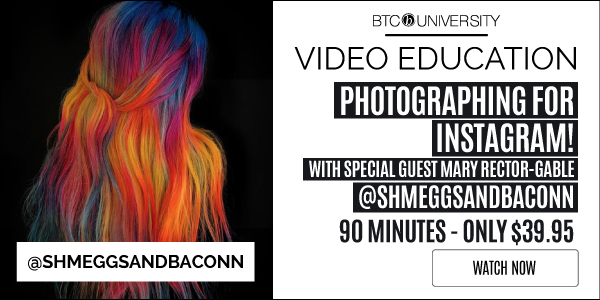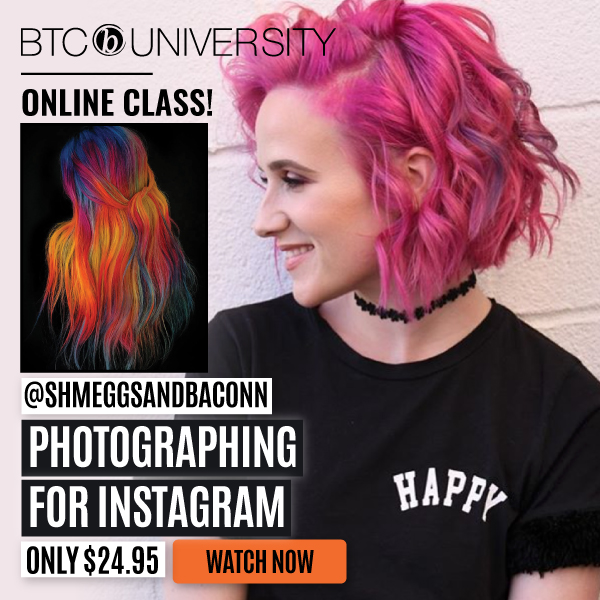B(L)ack to Blonde — A Boxed Haircolor Story
We’ve all been there (and if you haven’t, you will). A client comes in with Level 1 jet black hair—from a box, of course—and expects an easy-breezy transition to blonde. So what’s a hairdresser to do? A stylist-in-need recently posed this question to the BTC Community: “My client came in with black box ‘dye’ in her hair and asked to become a Level 9 blonde. At this point, I have stripped and lightened her hair with an ultra-lift ash. Now she is a Level 7 with orange and yellow tones. What next?” Here’s how BTC Members recommend dealing with this sticky situation.
Strand and Deliver
First thing’s first. A strand test is a must. Kat Jane Bowbrick says: “Can’t say it enough!! Strand test strand test strand test!! Then the client has a realistic view of what is going to be achieved on appointment number one.” “Better to have 50 strands of cotton candy hair versus an entire head,” says Melissa Herald Rodgers. “Nothing conveys ‘You’re going to hate it’ like pulling on each end of the strand and watching it disintegrate. The client’s face will answer all her own questions.” Alexis Nicole Loper agrees. “This is EXACTLY why strand testing is SOOO important!” she declares. “Sometimes you have to tell your clients ‘You can’t have that.’ Like Melissa said, when they see how fried their strand test is, they WON’T want to do it to the entire head.”
Consult to Get the Best Result
“In this scenario, consultation is KEY!” says Jeni Lahuanani. Before you even begin, you have to be honest with your client and make sure she understands the time and effort that will go into the process. “I’ll tell my clients ‘I will do as much as your hair will LET me do,’ and I fully advise them of all the different things that could happen to their hair,” Jeni states. “I make sure to have a very in-depth consultation. I want [my clients] to have realistic expectations. Always under-promise and over-deliver.” Alyson Hoadley also conducts a thorough consultation with her clients, reminding them that preserving the quality of the hair is most important. “Show her an anticipated color,” she says. “Usually around a Level 7 warm to start. If you obtain a level higher, that’s a bonus. Then suggest treatments and care for her at home and book a future appointment to continue with highlights and toner to get her to reach her goal.”
Go For the Trim
If one thing is for sure in this scenario, it’s that your client is going to need a good trim—so don’t be afraid to use those shears! “If she’s colored it black, I can guarantee it had a few layers of color on it underneath,” says Stachia Bennings. “Trim 3 to 5 inches off, and don’t give her an option! It will break off anyway from being lightened.” Chelsea Ruybalid echoes this sentiment. “She’s going to need a good cut and a deep condition!” she says.
Take it Slow
Hopefully your consultation went well and your client understands the necessity to take things slow. This means multiple appointments, and a lot of patience on both her and your end. “I normally would start with a full highlight and get them as light as I can, then tone, and then repeat this process every few weeks until she’s at the level she wants to be,” says Shelly Hausfeld Snyder. “This would be gentler on the hair and would look prettier.” Ashley Kristine Twilling says multiple visits is the only realistic and safe way to solve this dilemma. “Several foils every 6 to 8 weeks,” says Ashley. “Make sure your guest knows it’s going to be trial and error!”
Foil and Tone
Many BTC Members agree that it’s best not to use a lightener in this case. Instead, they advise, opt for foils and toner. “I never ‘strip’ or do corrective washes on hair that dark and with that much box color,” says Stachia. “I ALWAYS foil hair with box color on it. The hair will lift so unevenly when metallic (box) color is present and will look streaky and patchy without the blending of foil. The foil also helps lift a little higher.” Sarah Renné Pontius agrees. “Foil foil foil! Heavy highlight! Don’t apply lightener all over,” she advises. “You will have more control with foils and toning. Do it until the desired level is achieved and as often as you safely can. It will become an expensive process for her, but with the right consultation and explanation, it will be worth it to save the integrity of her hair.” Taking it one step further, most stylists recommend using a cool, acidic shade—such as a violet or blue—to tone the hair. “I would only do a good highlight with 30-volume bleach, and it will have to be toned with something strongly blue-violet,” advises Mike Muniz. “Next time, same process…next time, same process adjusting down the volume of the lightener on the new growth until there is enough regrowth to consider transitioning her to color.”
Olaplex to the Rescue
Finally, if you haven’t tried it yet, most BTC Members agree you should take advantage of “The Holy Grail of Haircolor.” “I’m in love with Olaplex!” declares Becca Burrows. “You just need to use it when you’re lightening hair. It protects the hair and helps the bleach do its job. I just did this yesterday and got my friend from a Level 1 to a Level 6, and her hair is still soft and strong—no breakage!” Praised by an army of celebrity colorists, Olaplex prevents breakage and provides controlled lift—all while helping hair become stronger, silkier and fuller. “I would mix Olaplex into your next full highlights,” says Lisa Li. “This product is awesome. Believe the directions when they say to use a level higher of your developer. It processes more slowly, but the final result is great—and the integrity of the hair is preserved.”









